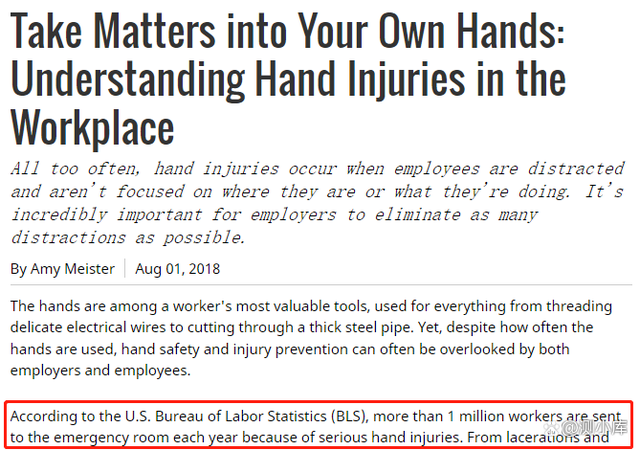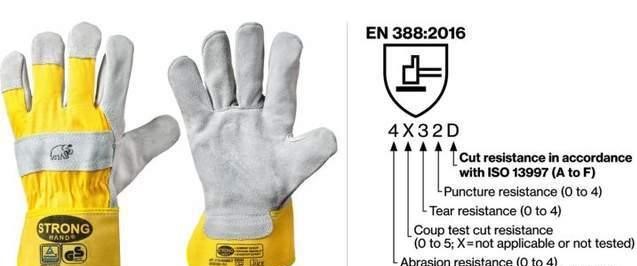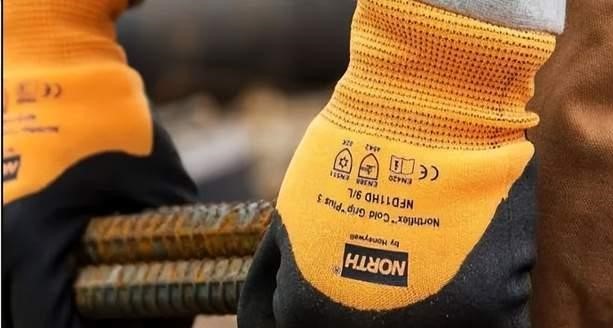According to the U.S. Bureau of Labor Statistics (BLS), there are 110,000 hand injuries each year, and more than 1 million workers are sent to emergency rooms for serious hand injuries. More than 70% of workers with hand injuries did not wear protective gloves on-site, and the remaining 30% of injured workers wore protective gloves, but the protective gloves were unsuitable, damaged or did not match the job hazard.
Hands play an important role in the production and labor process. However, the hand is also an easily injured part, accounting for about 25% of the total number of industrial injuries. Fire and high temperature, electricity, chemical substances, impacts, cuts, abrasions, and infections can all cause injuries to the hand. Mechanical injuries such as impacts and cuts are more common, but electrical injuries and radiation injuries have more serious consequences, which may lead to disability or even die. To avoid injury to workers' hands during labor, the role of protective gloves is particularly important.

Protective gloves inspection reference standard
In March 2020, the European Union published a new standard: EN ISO 21420: 2019 General requirements and test methods for protective gloves. Manufacturers of protective gloves must ensure that the materials used in the production of products do not affect the health of operators. The new EN ISO 21420 standard replaces the EN 420 standard. In addition, EN 388 is one of the European standards for industrial protective gloves, and the European Committee for Standardization (CEN) approved the version EN388:2003 on July 2, 2003. EN388:2016 was published in November 2016, replacing EN388:2003, and revised in 2018 to supplement EN388:2016+A1:2018.
Related standards for protective gloves:
EN 407 Standard for fire and heat resistant gloves
EN 374 Requirements for chemical penetration resistance of protective gloves
EN 511 Regulatory Standard for Cold and Low Temperature Resistant Gloves
EN 455 Protective Gloves Impact Cut Protection
Test method for protective gloves
In order to protect the safety of consumers and avoid losses for dealers due to product quality recalls, all protective gloves exported to EU countries must pass the following inspections:
1. Field test
EN388:2016 Marking Instructions

1.1 Abrasion resistance
Take the material of the palm of the glove, wear it with sandpaper under a fixed pressure, and calculate the number of revolutions until a hole appears in the worn material. According to the table below, the wear level is represented by a number between 1 and 4. The higher, the better the abrasion resistance.
1.2 Blade Cut Resistance-Coupe
A rotating circular blade is moved horizontally back and forth across the glove sample, and the number of blade rotations is recorded as the blade penetrates the sample. Use the same blade to test the number of cuts through the standard canvas before and after the sample test, and compare the wear degree of the blade during the sample and the canvas test to determine the cutting resistance grade of the sample. digital representation.
1.3 Tear Resistance
The material of the palm of the glove is torn by a tensile device, and the tear resistance grade of the product is judged by calculating the force value required for tearing, which is represented by a number between 1 and 4. The larger the force value, the better the tear resistance. (Considering the characteristics of textile materials, the warp and weft direction, tear test includes transverse and longitudinal tests.)
1.4 Puncture Resistance
Use a standard puncturing needle to pierce the material of the palm of the glove, and determine the puncture resistance level of the product by calculating the force used for puncturing, which is represented by a number between 1 and 4. The larger the force value, the better the puncture resistance.
1.5 Cut Resistance - ISO 13997 TDM Test
The TDM cutting test is to use the blade to cut the material of the palm of the glove at a constant speed, and test the running length of the blade when cutting through the sample under different loads. Use a precise mathematical formula to calculate (slope) to get how much force needs to be applied to make the blade travel 20mm Cut the sample through.
This test is a newly added item in EN388:2016, and the result grade is represented by A-F, with F being the highest grade. Compared with the EN 388:2003 coupe test, the TDM test can provide a more accurate working cut resistance index.
1.6 Impact protection Impact resistance (EN 13594)

The sixth character stands for impact protection, which is an optional test. If the glove has been tested for impact protection, this information is given by the letter P as the sixth and final symbol. Without P, the glove has no impact protection.
protective gloves
2. Appearance inspection of protective gloves
- Manufacturer's name
- Gloves and sizes
- CE mark
- EN Standard Marking Diagram
These markings should remain legible throughout the life of the glove
3. Packaging inspection of protective gloves
- the name and address of the manufacturer or representative
- Gloves and sizes
- CE mark
- it is the intended application/usage level, e.g. "only for minimal risk"
- If the glove only provides protection to a specific area of the hand, this must be stated, e.g. "palm protection only"
4. Protective gloves come with instructions or operation manuals
- the name and address of the manufacturer or representative
- Glove name
- Available size range
- CE mark
- Care and storage instructions
- Instructions for use and limitations
- List of allergenic substances in gloves
- Inventory of all substances in gloves on request
- The name and address of the certification body that certified the product
- Basic standard
5. Innocent requirements for protective gloves
- Gloves must provide maximum protection;
- If the glove has seams, it should not degrade the performance of the glove;
- pH should be between 3.5 and 9.5;
- Chromium (VI) content should be lower than the detected value (<3ppm);
- Natural rubber gloves should be tested on extractable proteins to ensure they do not cause allergic reactions to the wearer;
- If cleaning instructions are provided, the performance level must not be reduced even after the maximum number of washes.
The EU Standard for Safety Gloves can help workers determine which gloves have the appropriate level of protection in the work environment against the corresponding mechanical risks. For example, construction workers may often encounter abrasion hazards and need to choose gloves with higher wear resistance, while metal workers need to prevent cutting tools from cutting injuries or scratches from sharp metal edges, which requires the choice of protective gloves with higher cutting resistance.
QCANT™ Quality Control Service Provider,Partner of SGS,TUV,Intertek provide variety of professional inspection and auditing services with 180+ inspecters to ensure goods meet buyer requirements and regulations in the supply chains. QCANT Pricing begin with ALL included only $198/MD for Inspection in China, 5 minutes to make an online booking , get order scheduled and 99% receive report within 24 hours